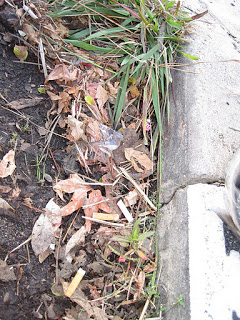The rainy season is a good time for us to begin to observe what works and what doesn’t work. Your observations can begin up at the top of your watershed in the mountains nearby, or down at the estuaries leading into the oceans, or even in your own neighborhood and yard. When it rains, watch the rain pouring off your roof to see where it flows. Watch the water coming out of your downspout: where is this resource being directed. Watch the water moving off your driveway, walkways, soil: where is water flowing, pooling. We can learn so much about what small steps we can use to harness natural energies.

I noticed this, this morning after a day of rain yesterday and got so excited about the teaching opportunity exhibited. Here the street is eroding so there are areas where sediment gets deposited when the water flows. Soon enough, weeds have populated this area and grown enough to impede the flow of water just enough to catch debris during the water’s journey down the storm drain and out to our river and ocean. A “healthy” collection of cigarette butts, plastic, leaves, seeds, sediment, and things we can’t see see trapped by this debris like oil, copper from car brakes, bacteria from animal poop populate the area upstream of this weed. Additionally, more seeds have been able to germinate in the building sediment and nutrients accumulating (can you spot the milkweed growing?). This is what happens in nature!! Far upstream starting in the mountains, where the water flows are occurring naturally, plants filter all kinds of contaminants out of the water flow as well as slowing the water flow so it can have a chance to soak into the ground along the way to hydrate the soil and plant life in these areas. What happens when we raze a hillside and pave it with rooftops, driveways, and storm drains with no opportunities for this natural filtration? We get huge volumes of water flowing at difficult to manage velocities, with massive amount of pollutants, headed straight for our waterways which are ill-equipped to naturally handle the influx of volume and bacteria. Thus our beaches are shut down, our aquatic flora and fauna are threatened, and flooding creates more need for $$ to build infrastructure to handle all of it!
Small changes like this are the first step to helping us rebuild what we have destroyed. If only we can use our observation skills in combination with our problem solving skills in combination with our compassion for each other as well as even the smallest living thing, we may have a chance at building something at least not degenerative… maybe we can even strive beyond sustainability to regenerative design (leaving something better, more productive than how you found it).

